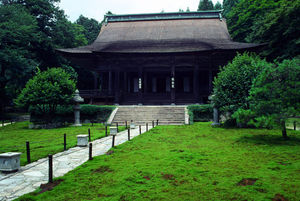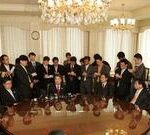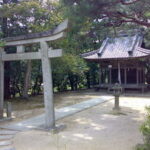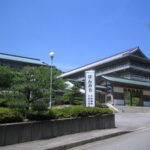Shinto and Buddhism are two of the most influential and pervading traditions in Japanese religion. While both of these traditions are important to consider when attempting to gain an understanding of Japanese religion, it is worth noting that Shinto is the only major religion to originate on Japanese soil. Buddhism originated in India, and through China and Korea was a Japanese import.
Shinto was the main “channel” by which many of the earlier religious traditions in Japan were transmitted to the later generations and preserved. Before the name “Shinto” was applied, Japanese religious traditions were loosely organized, usually around the family. When Buddhism (“the way of the Buddha”) was introduced near the middle of the sixth century C.E., the traditional Japanese practitioners set their religious traditions apart by referring to their religious rites as “Shinto” (“the way of the kami“).
The Kojiki and the Nihonji are two of the oldest written records we have from Japan, and they highlight some important aspects of early Japanese religion that helped to create the context leading to the formation of Shinto. Two of these aspects are the divine/semi-divine descent of Japan and her people and the abundance of divinities known as kami (as well as their interconnectedness with the land and people of Japan).
The most important factors in the practice of Shinto religion are a respect for the kami (the “sacred,” whether specific divinities, ancestral spirits, or even humans, among other things) and the voluntary participation in shrine ceremonies.
Rites and celebrations in the Shinto religion center on shrines (as opposed to Buddhist temples). There is a theory that states that in ancient Japanese religious tradition there were no shrine buildings, but that an actual area was sectioned off as sacred, around a certain physical manifestation such as a tree or a rock where ancestral spirits supposedly lived. Later Shinto shrines have consisted of buildings of various sizes with a worship hall and a smaller kami hall, where the spirits are said to make their descent. In ancient times, unmarried princesses would serve as priestesses at certain shrines and would preside over certain rituals, playing an important role in both religion and in government. Later priests were male, and women acted only as assistants or laborers to the priests.
While Shinto is said not to have created new forms of religious practice in Japan, but rather to have unified and organized the preexisting traditions, the scholar Muraoko Tsunetsugu wrote that there are three distinctive characteristics of the Shinto religion: 1) Shinto’s emphasis on the identity of the Japanese nation with the imperial family and the descent of this family from the ancestral kami (a political characteristic); 2) Shinto’s practice of a “realistic” affirmation of life and values in this world, accepting life and death, good and evil, as inevitable parts of the world we live in (a philosophical characteristic); and 3) Shinto’s reverence for the “bright” and “pure” in all matter and thought, and its attempt to overcome physical pollution with rites of exorcism and bad thoughts with a “pure and bright heart” (an ethical characteristic).Shinto arose partly as a reaction to the importation of Buddhism into Japanese culture, as a way to contrast the existing Japanese religious traditions with the foreign Chinese and Korean influences. Yet the importation of Buddhism also contributed a factor of imitation to Shinto, and eventually Buddhist art and ritual were implemented in Shinto shrines as well as Buddhist temples.
In the Nihongi, it is recorded that in the middle of the sixth century C.E. the ruler of a Korean territory offered tribute to the Japanese court for political purposes, and that the tribute included Buddhist images, ritual decorations, and scriptures. This is seen as the formal introduction of Buddhism to Japan, and its acceptance is better understood when considering the Japanese religious traditions of the time had no statuary or scriptures of their own. Buddhism is similar to Shinto in that it is a religious discipline not strictly based on doctrinal adherence, which may be one reason why the two religions are often seen as being more complementary than conflicting or competitive. Both religions had their shrines or temples, their respective kami or divinities, their ritual prayers or scripture and rites, and priests. Even the Buddhist notion of reincarnation seems to correspond to the Shinto idea of kami, in that the Buddhist “deities” can be considered physical manifestations of the “hidden” spirits of Japan. In both Shinto shrines and Buddhist temples, it was easy for the populace to connect the unseen kami with the Buddhist statuary.
Buddhism and Shinto are interrelated in the lives of the Japanese people even today, where many are married in Shinto shrines yet carry out memorial services in Buddhist temples. Many families have small Buddhist altars in their homes memorializing the dead, and at one time Buddhist funerals were even required by law. The interaction between Buddhist and Shinto traditions has led to a sort of amalgamation of religious practices in which one tradition influences the other without apparent contradiction. While one or the other of the two may have a stronger or weaker presence than the other at a given time in history, neither disappears entirely, and the relationship between the two is never severed completely.
Sources:
Earhart, H. Byron. Japanese Religion: Unity and Diversity. 4th ed. Belmont, CA: Thomson/Wadsworth, 2004.
Earhart, H. Byron. Religion in the Japanese Experience: Sources and Interpretations. 2nd ed. Belmont, CA: Wadsworth, 1997.





